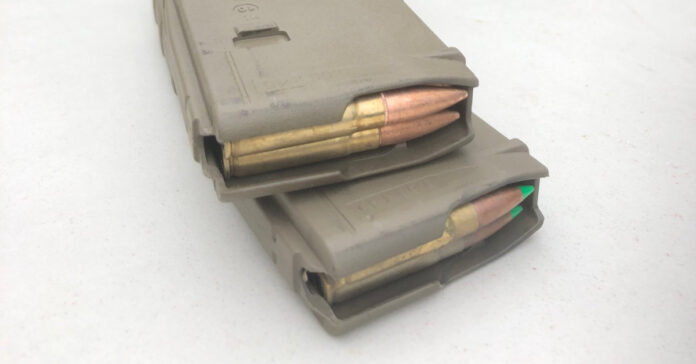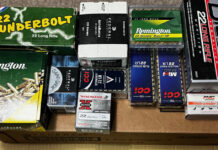I finally had a chance to play with the new .30 caliber Banish suppressor and my .300 blackout guns, and things didn’t quite turn out as I expected.
The suppressor worked fine; but after testing, my intended use for it that changed. Let me explain.
A Quick Update
For those of you who read the prior post on my new suppressor, removing the flash hider from my AR pistol with an AR15 wrench proved to be impossible because the handguard was so close to the threads on the barrel that the wrench didn’t have clearance. The good news is that using a standard three-quarter-inch open-ended wrench worked just fine, just as a reader had suggested. The head on that wrench was thin enough that it could get purchase on the flash hider’s flat without bumping into the forearm.
Doesn’t that just figure? I have a fancy AR tool and the Craftsman wrench in my workshop does the job better.
I applied a dab of anti-seize compound, screwed on the suppressor, and we were off to the range.
Testing Protocol
I tested the suppressor on two AR-style guns with .300 blackout barrels, both of which I built myself. One has a 16-inch barrel and a 5x Primary Arms ACSS optic. The other has a 10.5-inch barrel and a Primary Arms red dot with no magnification. I fired both guns with 150-grain supersonic bullets, 220 grain sub-sonic bullets, and then removed the flash hider, screwed on the suppressor, and tested the same bullets on the same targets.
Because I do not have a decibel meter, I downloaded the Sound Meter app for my iPhone. I cannot attest to how accurate this app is, but I expect it is less accurate than a dedicated, professional sound meter would be. Nonetheless, the app confirmed that rounds fired through the suppressor are in deed quieter.
I initially set the phone on the shooting bench, but I found that any bump on the bench would cause the meter to shoot upwards. Once, when I dropped something on the bench, it registered 105 decibels, which was more than any of the shots I fired. I had to compromise by moving the meter to the next bench over, where no one was sitting. So the readings are from about 6 feet away, behind the muzzle.
Unsuppressed Results
The supersonic ammo rated between 95 to 98 decibels from both guns when unsuppressed. Below is the very first group I fired from each gun using the 150 grain supersonic ammo. I was happy that both guns retained their zero.
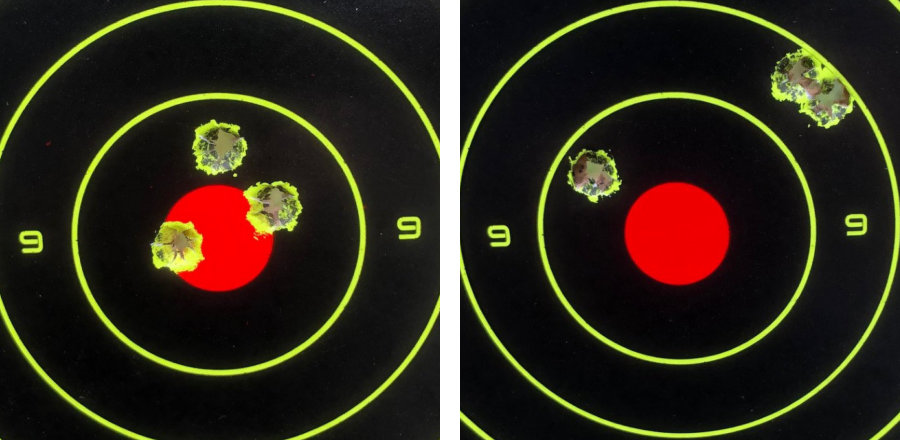
The subsonic ammo was 92 and 94 decibels. Below are those targets. Note that using the subsonic ammo in the pistol skewed the point of impact to the left slightly. I don’t know why, but keep this in mind as you read on.
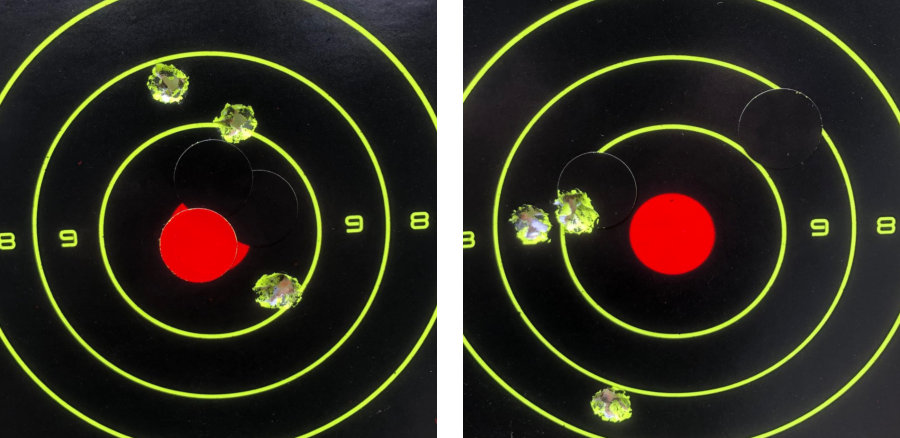
In each case, the shorter barrel was louder.
My initial impressions were that both the guns were quieter than I expected. I can only think that 1) the inferior quality of my sound monitoring equipment contributed to this and/or 2) I erred by placing the microphone behind the muzzle. Unfortunately, I did not think to test the sound 10 feet in front of a gun. I know from experienced that shooting a compensated pistol is far quieter behind the gun than in front, and it makes sense the sound waves travel out the barrel. I guess it all depends if you want a suppressor because you want to protect the shooter’s ears or because you want someone down range not to detect the gunshot.
Suppressed Results
Even with the less-than stellar sound monitoring equipment, the suppressor lowered the noise level 20 to 22 decibels. The rifle ammo came in at 73 and 77 decibels, while the subsonic ammo came in at 75 and 76 decibels. Again, the AR pistol with its shorter barrel was louder.
To put this number in perspective, the software rated me walking on gravel at 55 decibels. The ambient noise was in the low 40s, which it considered a silent environment.
I should note that after the first shot, I took off my hearing protection, and it was comfortable to shoot with them off. It was interesting to hear the crack of the bullet breaking the sound barrier (which I had heard of but never heard) and even the impact on the berm behind the target. These are things I missed when wearing earplugs and muffs.
Here’s the two targets from the rifle shooting the supersonic and subsonic ammo.
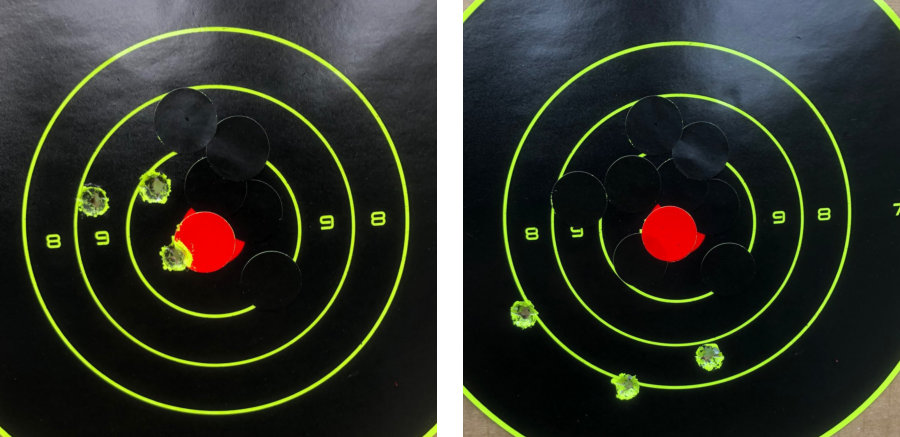
Surprise
The biggest surprise comes from the point of aim shifting when I shot the pistol with the suppressor in place. The supersonic ammo gave a great group with all three bullets touching, but it was three inches to the left. Then I tried the subsonic ammo, and it was a good 5 inches to the left, completely off the target.
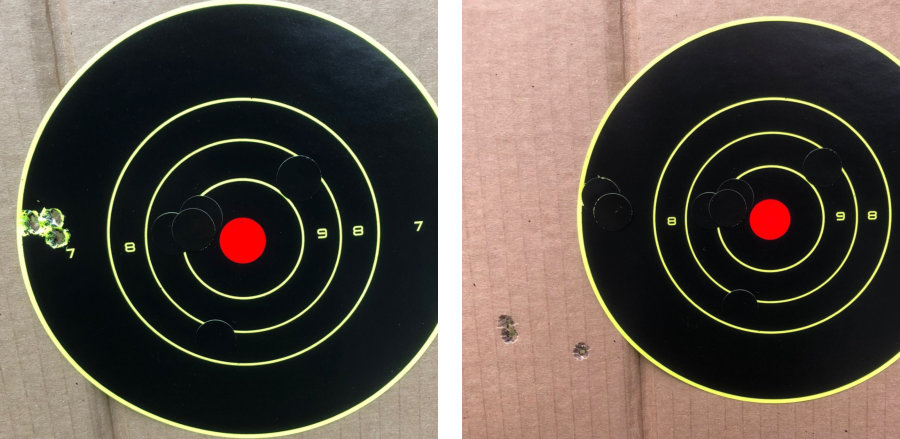
After seeing that group, I unscrewed the suppressor and screwed it back on, just to be sure. The group was off to the right again. WTF? I mean, the rifle groups were slightly to the left after the suppressor was on, but not that much. I removed the suppressor from the pistol, screwed it back onto the rifle and shot a group that was pretty much on target. Then I shot a group through the pistol without the suppressor and it was much closer to center. It appears that the combination of the suppressor and the AR pistol, with either ammo, is a bad one, and a terrible one with the American Eagle 220 grain OTM subsonic round.
I disassembled the suppressor and looked at the baffles and I didn’t see any problems. The bullet is going straight through and not hitting the baffles or the end cap. Perhaps the manufacturer cut the threads on the 10.5″ barrel slightly off square or the shoulder is not flat. I am also tempted to put a crush washer on and then thread on the suppressor, and see if that changes the point of impact.
I am also planning to test it with some Hornady and Remington subsonic ammo and see if the point of impact changes. More testing is definitely needed. (Too bad I cleaned that gun already.)
Resolution

Am I happy with the Banish 30? Yes, it effectively reduces the sound signature as advertised, but I feel a bit let down that the combination of my AR pistol and the suppressor is not a winning one. I had intended to mount the suppressor on my pistol and use it with the subsonic ammo, hoping for a very quiet gun. Perhaps that was wishful thinking or unrealistic expectations based on seeing too many movies and videos. Because this combination shifts the point of aim so far, (at least with one type of ammo), that is no longer my plan.
Instead, I am going to mount the suppressor on the rifle, bringing it to an overall length of 43 inches, and shoot it with the 150 grain ammo. This is going to be my hunting rifle and also a primary “zombie-killer” rifle during a SHTF scenario. The combination is highly accurate, and I’m not going to worry about the supersonic crack. It’s not like I am taking out sentries, engaging multiple wild hogs at one time, or doing something where super stealth is required. In our narrow valleys, it’s difficult to tell where un-suppressed shots come from. I expect that will be even harder with a suppressed round as the supersonic crack echoes back and forth.
I am also going to test that combination with some of the 120 and 110 grain ammo I have on hand as those are supposed to be the top performers with the increased speed giving the rounds more foot-pounds of energy.
Suppressors for Preppers
I haven’t used the suppressor enough to give a good answer on how they are be best used for prepping. In hindsight, I might have been better off buying a suppressor for 22 rimfire. I think a suppressed .22LR, which can be quieter than a pellet gun (if YouTube is to be believed) might be useful for taking small game and stealth hunting.
If a fellow prepper asked me if they would be better off spending $1,500 on a suppressor and tax stamp or on an additional 2,000 or 3,000 rounds of ammo, I’d say go for the ammo.

